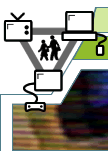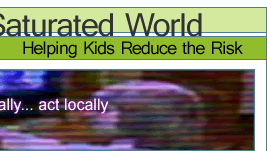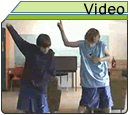Media Risk Reduction Strategy
This media risk reduction strategy uses a two-pronged social
marketing campaign to convince elementary students to participate
in an experiment. The experiment addresses the question 'What
would you do if you turned off TV, video games and PC’s
for a whole week?'
The object of this exercise is to explore what else there
is to do instead.
The first prong is the Media Education Component: we will
go into their classrooms and talk to the children about what
and how they use media.
A) What is it that we can do to motivate children
to watch less TV?
AUDIT: you can’t change what you can’t
see: A week long media diary will be used to get students
to study and discuss their own media usage patterns. Parents
will also be encoraged to particpate in the media audit to
encourage discussions about media use within the family.
MEDIA EDUCATION: Children spend more time
with media than they do in the classroom. But they cannot
check the knowledge, attitudes and social behaviours they
are exposed to in popular culture at the school door. Since
children bring their fascinations and interest in popular
culture with them into the school, media educators developed
strategies for dealing with media within the framework of
a curricullum. The approach this project based on sees media
education as a kind of ‘judo’ that absorbs to
the force of popular culture on children by critically reframing
their relationship to it in the classroom.
We have developed a four phase curricullum which uses learning
exercises which helps children understand the role that media
play in their lives. Each lesson has both media education
and approved curricullum goals which include research, art,
writing, social skills and, math and creative problem solving
aspects to them and children will be given homework assignments
such as interviewing their parents or keeping a diary.
Week 1) Media Audit. This first week allowed
the students to get to know the researchers from SFU by expressing
their preferences for certain television programmes, video
game and computer related activities. The aim was to make
the children feel comforable enought to speak freely about
their media use patterns. We then asked them to fill out a
week long media diary asking how long they spent with media
and what shows, games and computer related activities they
engaged in. On the last day of the week we came back to the
school and conducted a media math lesson, which asked
the students to add up all their media use for the week. This
approach allowed the students to see for themselves the amount
of media they used, rather than being told they watch just
enough or too much, they made their own judgments. Most of
the students did however, decide they spent too much time
with the media and the project allowed the students to direct
their future decisions based on their own empirical evidence
from their own survey data.
Media Education Program
Week 2) Heroes and Heroines. This unit looks
at the hero asking children to identify thecharacteristics
that they admire. Children get to discuss both their own personal
heroes and fictional heroes that they see on television.
Week 3) Scripting and Re-scripting. This
unit looks at the idea of the villain or ‘bad guy’.
It goes on to discuss what makes characters villains by comparing
the conflict in media with examples of bullying. The class
discusses character stereotypes and the types of programmes
and games in which conflict is a central part of the story.
Students are taught to apply this analysis of bullying behaviour
to scenes they find in media.
Week 4) Fair Play as moral principle. This
lesson will ask children to examine the games they like to
play and what makes play fun. Children will interview their
parents about the games they like to play as children. The
unit explores the difference between conflict and cooperation
in games and the way limits and rules help make games both
fair and fun. We look at the variety of games such as hop
scotch, skipping games and ask them to create a game of their
own using 4 objects. Groups will discuss the rules and objectives
of their game explaining what happens if anyone play’s
too rough or breaks the agreed rules.
Week 5) Tune Out Week. The final unit is
preparation for the Tune Out the Screen Challenge. The activities
involve making posters, T-shirts, writing stories or advertisements
to encourage others to Tune Out the Screen. Children will
decide what approach they wish to try which range from making
no change to going cold turkey screen free. They will also
be asked to plan alternative activities so they can enjoy
the free time they gain during Tune Out week. Parents will
be asked to support the children in finding alternative actitivies
and to help them make healther lifestyle choices. Children
will keep a diary which helps evaluate how well they achieved
their plan. Both parents and children will be part of the
challenge evaluation and debriefing.
|





